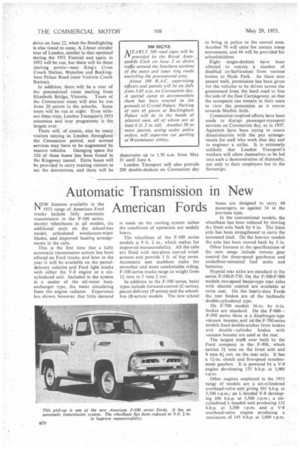Automatic Transmission in New American Fords
Page 54

If you've noticed an error in this article please click here to report it so we can fix it.
NEW features available in the 1953 range of American Ford trucks include fully automatic transmission in the F-100 series, . shorter wheelbases in all models, six additional seats on the school-bus model, articulated windscreen-wiper blades, and improved heating arrangements in the cabs.
This is the first time that a fully automatic transmission system has been offered on Ford trucks, and later in the year it will be available on the parceldelivery vehicles and Ford light trucks with either the V-8 engine or a sixeylindered unit. Included in the system is a cooler of the oil-water heatexchanger type, the water circulating from the engine radiator. Experience ha, shown, however, that little demand
is made on the cooling system unless the conditions of operation are unduly heavy.
The wheelbase of the F-100 series models is 9 ft. 2 in., which makes for improved mameuvrability. All the cabs are fitted with one-piece curved windscreens and provide 5 ft. of hip room. Automatic seat snubbers make for smoother and more comfortable riding. F-I00 series trucks range in weight from 1 tons to 2 tons 2 cwt.
In addition to the F-100 series, basic types include forward-control (C-series), parcel-delivery (P-series) and the schoolbus (B-series) models The new school buses are designed to carry 60 passengers, as against 54 in the previous type.
In the conventional models, the wheelbase has been reduced by moving the front axle back by 4 in. The front axle has been strengthened to carry the increased load. On the heavier models the axle has been moved back by 3 in.
Other features in the specifications of the -new range include remote gear control for three-speed gearboxes and underfloor-mounted fuel tanks and batteries.
Hypoid rear axles are standard in the series F-100-F-750. On the F-500-F-900 models two-speed banjo-type rear axles with electric control are available at extra cost. On the heavy-duty Fords the rear brakes are of the hydraulic double-cylindercd type.
On F-700 models I6-in. by 6-in. brakes are standard. On the F-600-F-900 series there is a diaphragm-type vacuum booster, and on the F-700 series models fixed double-anchor front brakes and double cylinder brakes with vacuum booster are used at the rear.
The largest truck ever built by the Ford company is the F-900, which carries 3f tons on the front axle and 9 tons 8f cwt. on the rear axle. It has a 12-in, clutch and five-speed synchromesh gearbox. It is powered by a V-8 engine developing 155 b.h.p. at 3,900 r.p.m.
Other engines employed in the 1953 range of models are a six-cylindered overhead-valve unit giving 101 b.h.p. at 3,500 r.p.m.; an L-headed V-8 developing 106 b.h.p. at 3,500 r.p.m.; a sixcylindered 1-headed unit producing 112 b.h.p. at 3,500 r.p.m. and a V-8 overhead-valve engine producing a maximum of 145 b.h.p. at 3,800 r.p.m.




























































































